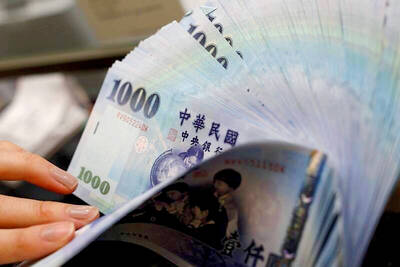Foxconn Technology Group (富士康科技集團) plans to acquire display start-up eLux Inc for about US$27.03 million in cash via four subsidiaries, including Sharp Corp, in an effort to accelerate its development of next-generation micro-LED display technology, company statements said on Monday.
The acquisition could provide a fast track for Foxconn — known as Hon Hai Precision Industry Co (鴻海精密) in Taiwan — to commercialize micro-LED technology, which industry experts say could exceed organic LED (OLED) technology.
Micro-LED shares traits with OLED, but costs less.
Foxconn’s latest move came as its top clients, Apple Inc and Sony Corp, have been investing in micro-LED in pursuit of an alternative to OLED technology, seeking similar energy efficiency and ultra-high-definition display advantages at cheaper costs.
Apple is expected to crank out a small volume of next-generation micro-LED displays for wearable devices from a plant in Taoyuan’s Longtan District (龍潭) by the end of this year, IDC analyst Annabelle Hsu (徐美雯) said in March.
Apple has placed more focus on micro-LED after acquiring LuxVue Technology Corp in 2014.
Foxconn’s Cyber Venture Capital Corp, Sharp, Innolux Corp (群創) and Advanced Optoelectronic Technology Inc (AOT, 榮創) have inked agreements to invest in eLux, Sharp and Innolux said in separate statements.
Following the investments, Cyber Venture will hold the biggest stake of 45.45 percent in eLux, while Sharp and Innolux will own 31.82 percent and 13.64 percent respectively, the statements said. AOT will hold 9.09 percent.
Sharp will acquire the rights to 21 patents developed by eLux, Sharp’s statement said.
“Cooperation between Innolux’s research and development team in Taiwan and eLux’s team in the US will help accelerate the development of next-generation display technology,” Innolux said in its statement.
The deal is expected to be completed in October, Sharp said.
ELux was established in October last year in Delaware, according to information provided by Sharp.
Taipei-based TrendForce Corp (集邦科技) said that micro-LED technology is to have a market value of between US$30 billion and US$40 billion per year once it fully replaces mainstay LCD technology.
The new technology is expected to become mainstream in three to five years, TrendForce said.
The manufacturing costs of micro-LED panels are still high, about three to four times their LCD equivalents, it said.
IDC said it expects micro-LED to become commercially available in 2020.
Micro-LED panels are suitable for smartphones and virtual-reality or augmented-reality devices due to the high demand for picture quality demanded by those products, TrendForce said.

Merida Industry Co (美利達) has seen signs of recovery in the US and European markets this year, as customers are gradually depleting their inventories, the bicycle maker told shareholders yesterday. Given robust growth in new orders at its Taiwanese factory, coupled with its subsidiaries’ improving performance, Merida said it remains confident about the bicycle market’s prospects and expects steady growth in its core business this year. CAUTION ON CHINA However, the company must handle the Chinese market with great caution, as sales of road bikes there have declined significantly, affecting its revenue and profitability, Merida said in a statement, adding that it would

MARKET LEADERSHIP: Investors are flocking to Nvidia, drawn by the company’s long-term fundamntals, dominant position in the AI sector, and pricing and margin power Two years after Nvidia Corp made history by becoming the first chipmaker to achieve a US$1 trillion market capitalization, an even more remarkable milestone is within its grasp: becoming the first company to reach US$4 trillion. After the emergence of China’s DeepSeek (深度求索) sent the stock plunging earlier this year and stoked concerns that outlays on artificial intelligence (AI) infrastructure were set to slow, Nvidia shares have rallied back to a record. The company’s biggest customers remain full steam ahead on spending, much of which is flowing to its computing systems. Microsoft Corp, Meta Platforms Inc, Amazon.com Inc and Alphabet Inc are

RISING: Strong exports, and life insurance companies’ efforts to manage currency risks indicates the NT dollar would eventually pass the 29 level, an expert said The New Taiwan dollar yesterday rallied to its strongest in three years amid inflows to the nation’s stock market and broad-based weakness in the US dollar. Exporter sales of the US currency and a repatriation of funds from local asset managers also played a role, said two traders, who asked not to be identified as they were not authorized to speak publicly. State-owned banks were seen buying the greenback yesterday, but only at a moderate scale, the traders said. The local currency gained 0.77 percent, outperforming almost all of its Asian peers, to close at NT$29.165 per US dollar in Taipei trading yesterday. The

The US overtaking China as Taiwan’s top export destination could boost industrial development and wage growth, given the US is a high-income economy, an economist said yesterday. However, Taiwan still needs to diversify its export markets due to the unpredictability of US President Donald Trump’s administration, said Chiou Jiunn-rong (邱俊榮), an economics professor at National Central University. Taiwan’s exports soared to a record US$51.74 billion last month, driven by strong demand for artificial intelligence (AI) products and continued orders, with information and communication technology (ICT) and audio/video products leading all sectors. The US reclaimed its position as Taiwan’s top export market, accounting for